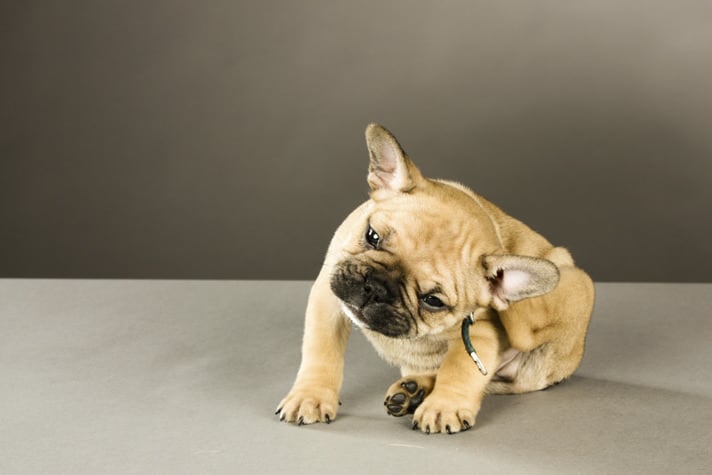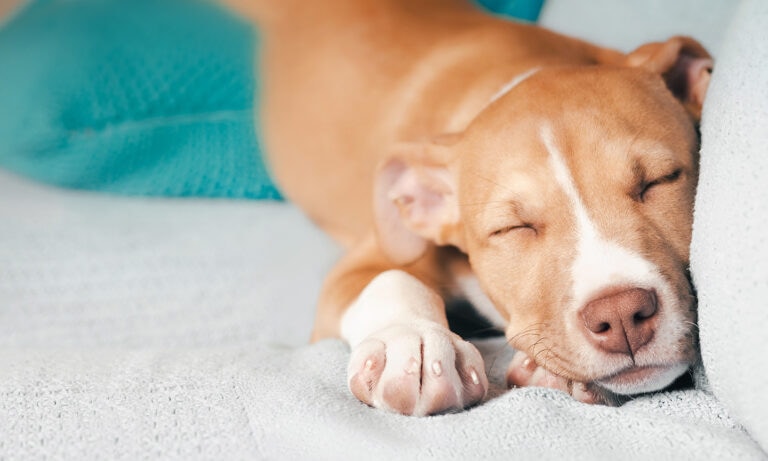Growing up, I cried, begged, pleaded, schemed and bargained for a puppy—any kind of puppy.
I never got a puppy.
All the dogs we had came to us at least a year or two old already. Over the years, we had big dogs, little dogs (technically a toy dog) and medium-sized dogs.
I grew up in a pet-friendly Ohio home. My childhood backyard is what I imagine would be a dog’s paradise: thick woods followed by a huge cornfield and another set of woods.
Probably not coincidentally, those same woods were beloved by fleas, ticks and other pests.
That meant that as soon as a new dog came on the scene, so did a new batch of flea and tick prevention medicine.
Why Do Fleas Cause Puppies To Itch?
Fleas are like little vampires; they dine on blood. They make people and puppies alike itch because they have an anti-coagulate in their saliva that keeps blood from clotting. This allows them to freely suck away on their host’s blood.
For many puppies, it’s more than just the flea’s bite that makes them itch. A common condition is flea allergy dermatitis (FAD), which occurs when dogs are allergic to the flea’s saliva, says Dr. Allison Habekost, DVM, with the San Clemente Veterinary Hospital in San Clemente, California.
Small or newborn puppies who have lots of fleas are susceptible to anemia. Or, if their immune systems are compromised in any way, that can make them more prone to health issues from fleas, Dr. Habekost says.
Prevent Fleas In Puppies
Your location is something to consider when deciding what method of flea prevention to use on your puppy. We lived in the Midwest where ticks in the woods were also a concern, so we opted for a once-a-month tablet that prevented both fleas and ticks.
Puppy owners in many other parts of the country with wooded areas share this same worry.
“It’s very important to treat for ticks as well as fleas in New Jersey, so the combination products [flea and tick prevention] are more important to us here,” says Dr. Douglas Cotler, DVM, with the South Brunswick Animal Hospital in Monmouth Junction, New Jersey.
Along with Lyme disease, there are numerous other tick-related diseases, Dr. Cotler says.
Flea prevention products for puppies come in a wide array of choices, such as:
- Monthly tablets or pills
- Monthly chewy treats (This is the newest form on the market available only for dogs, according to Dr. Cotler.)
- Collars that are effective for up to eight months
- Topical ointments, also called “topicals,” that are effective anywhere from one to three months, depending on the brand
Some flea products are specifically labeled for puppies. When you get a puppy, check to make sure he has already received dog flea treatments, regardless of whether he came from a breeder or a shelter, says Dr. Sheila Gomez, VMD, a dermatology expert in dogs and cats with NorthStar VETS in Robbinsville, New Jersey.
Another factor to consider when choosing a flea product is your puppy’s personality. Is he a master at recognizing pills and spitting them out? Then you may want to try a topical.
A Quick Way To Tell If Your Puppy Has Fleas
Do you suspect your puppy has fleas but you aren’t quite sure? Try this suggestion from Dr. Gomez:
- Buy a dog flea comb, which is a small comb, typically with metal teeth.
- Comb your puppy along the middle of the back, moving toward the hips and also around the neck. Those are spots that fleas typically like best.
- If you see what looks like little grains of pepper, that’s flea dirt. Flea dirt is a euphemism for flea poop.
- If you’re not sure what you’re seeing is flea dirt, take what’s on the comb and put it on a damp paper towel.
- Let the comb sit for a minute. If you see rust color on the comb, it’s a strong indicator your puppy has fleas.
So Your Puppy Has Fleas. What Next?
So let’s say your damp paper towel test came back positive for fleas. Here are the next steps to take:
Treat Your Puppy And All The Other Animals In The Home
If you have other dogs or cats, they likely will have fleas, too. Dr. Gomez recommends starting puppies with an oral medication that kills fleas within hours. Once all the pets have taken similar medication appropriate for them, then you can move on to monthly prevention products.
It may seem obvious, but remember to only use kitten products on kittens and puppy products on puppies. Always check the labels and read directions carefully.
Treat The Environment
Next, it’s time to bring out the big guns. You get to engage in some deep cleaning around your home and maybe even call an exterminator, depending on how bad the fleas are.
First, wash all the bedding, couch covers and pillows that the puppies and other animals lie on. Vacuuming and steam cleaning carpets is really important, Dr. Habekost says, because flea pupae can lay dormant for up to 350 days.
Pupae are one step in the flea life cycle: Eggs become larvae, which turn into pupae, where the fleas are in little cocoon-like capsules before they transform into adults that lay eggs.
If you do need flea bombs or exterminators, remember that some products may be toxic to pets, so keep them away from the home during treatment.
Here’s hoping you and your puppy never experience a flea infestation, thanks to your diligent flea-prevention efforts.
By: Laura Lee Bloor
Share:









